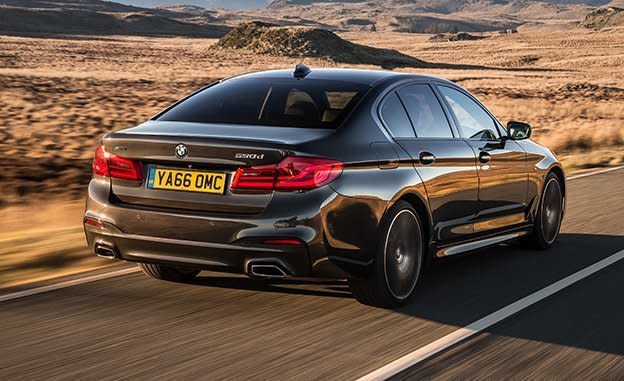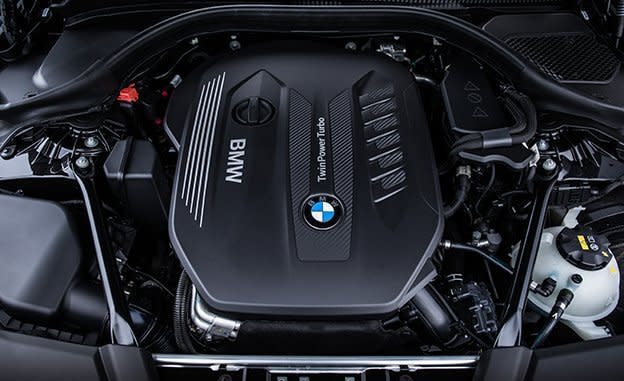2017 BMW 530d Euro-Spec

Rudolf Diesel, inventor of the compression-ignition engine that bears his name, allegedly drowned in the English Channel 103 years ago. While tragically unfortunate for the inventor himself, this is also bad news for those looking for a metaphor to frame the modern dilemma in which the diesel engine finds itself. At risk of sounding grossly insensitive, it would be much better for us if he had met his watery demise in the middle of the Atlantic Ocean, illustrating the radically different views that Europe and the U.S. have with regard to the automotive applications of his famous invention.
For BMW, diesels represented 6 percent of its U.S. sales in 2014, the last calendar year before the Volkswagen scandal limited their appeal further still. Meanwhile in Europe, compression-ignition remains utterly dominant, especially among premium automakers; in some European countries it is anticipated that 90 percent of sales of the new 5-series will be diesels. BMW’s recent commitment to U.S. diesel sales puts an optimistic spin on things, but there is as yet no confirmation that we will ever see a “d”-badged version of the new 5-series.

Sparkless of Interest
In the European Opposite Land, 5-series buyers can choose among as many diesel variants as we can gasoline engines. There’s a basic 2.0-liter inline-four 520d likely to spawn a detuned 518d variant, and then a 3.0-liter inline-six that gets progressively more powerful in its 530d and forthcoming 540d and M550d guises. The Euro-spec 530d M Sport that we drove for this review, complete with the optional all-wheel drive that BMW calls xDrive, stands the best chance of making it to the U.S. market.
It’s good; indeed, our time with it left us wondering whether—in anything barring raw output numbers—there is currently a better diesel engine on the market. Refinement of this new-generation “B57” diesel is outstanding, a point emphasized by just how quiet the new 5-series has become in terms of reduced wind and road noise. From inside the car at lower speeds, it’s pretty much impossible to tell that you’re running without spark plugs thanks to a soundtrack as refined as a gas engine’s. Even full load doesn’t produce anything more than a purposeful and pleasant growl. Although we didn’t have one handy for back-to-back comparison, we’re fairly certain it sounds at least as good as, if not better than, the gasoline 530i with its turbocharged four-cylinder.

Performance of the 530d is entirely adequate, if short of the face-distorting shove mustered by some of Europe’s brawnier performance diesels (and which we can safely predict the M550d will deliver). The 530d’s peak output of 261 horsepower is respectable, although it’s the 457-lb-ft torque peak—available from 2000 rpm—that gives the car its effortless demeanor. The standard ZF-sourced eight-speed automatic works best with the driving-mode switch left in its default Comfort setting because Sport has it changing down a gear on small accelerator applications when it doesn’t really need to, and we also have to criticize the light operation and plasticky feel of the steering-wheel shift paddles. Oh, and even Europeans can’t get a manual transmission with this model; sob!
Only when pushed hard does the 530d really speak to the truth of its fuel type, with the reluctance to rev characteristic of its genre. In drive, the gearbox upshifts at 4500 rpm, even at full, matted throttle. It can be made to rev higher in manual override, although no higher than 5250 rpm, still 250 revs shy of the indicated redline on the tachometer. It’s quickest when left to its own devices, with BMW’s claimed 5.4-second zero-to-62-mph time making it marginally quicker than the company’s claim for the 530i xDrive. The last U.S.-market 5-series diesel we tested, a 2014 535d, ran to 60 mph in 5.6 seconds.
The rest of the dynamic experience delivers the same speedy-but-sensible brief. While this 5-series definitely has sharper tack than non-AMG Mercedes-Benz E-classes, it’s still a fair way off the level of involvement offered by its predecessors, with electrically assisted power steering that delivers crisp front-end responses but nothing more than simulated feedback. And the xDrive system does a good impression of a Quattro-equipped Audi in terms of lack of drama. An electronically controlled clutch distributes torque between front and rear axles almost instantly, and its efficient operation effectively removes any of the rear-drive sensation we normally associate with brawny BMWs. A gain in failsafe motoring, but a loss in driver involvement.

Connected and Frugal
BMW is keen to emphasize the 5-series’s high level of connectivity—exciting news if you deeply desire a car only because it can synchronize with your diary and Microsoft Exchange email—as well as its plethora of advanced safety systems. Most of these keep a watchful eye in the background, but a stretch of Spanish autopista gave us a chance to test the semi-autonomous cruise control. While this manages straight stretches well, it struggled to apply enough steering to keep the car on track in tighter highway corners and wouldn’t change lanes when the turn-signal stalk was pressed. (Maybe we weren’t within the 43-to-112-mph window in which Lane Change Assistant functions, or maybe we didn’t hold the directional stalk long enough for its tastes.) It’s probably the one area where the 5-series feels notably inferior to the Drive Pilot–equipped E-class.
We hope BMW’s ongoing commitment to diesel power in the U.S. means that the 530d will make the trip across the Atlantic, because it would be a huge shame if we were denied this characterful and impressively frugal engine—our test car managed an indicated 37 mpg under enthusiastic use. Our test of the previous-generation model returned 32 mpg and wore a base price of $57,525. Based on our European drive, this new one is probably the most interesting new-generation 5-series so far, certainly this side of the forthcoming V-8–powered M550i xDrive. We think Americans would appreciate it.
Specifications >
VEHICLE TYPE: front-engine, rear- or all-wheel-drive, 5-passenger, 4-door sedan
ESTIMATED BASE PRICE: $62,000
ENGINE TYPE: turbocharged and intercooled DOHC 24-valve diesel inline-6, aluminum block and head, direct fuel injection
Displacement: 183 cu in, 2993 cc
Power: 261 hp @ 4000 rpm
Torque: 457 lb-ft @ 2000 rpm
TRANSMISSION: 8-speed automatic with manual shifting mode
DIMENSIONS:
Wheelbase: 117.1 in
Length: 194.3 in
Width: 73.5 in Height: 58.2 in
Passenger volume: 99 cu ft
Trunk volume: 19 cu ft
Curb weight (C/D est): 4200-4350 lb
PERFORMANCE (C/D EST):
Zero to 60 mph: 4.9-5.1 sec
Zero to 100 mph: 11.5-11.6 sec
Standing ¼-mile: 13.4-13.5 sec
Top speed: 155 mph
FUEL ECONOMY:
EPA combined/city/highway: 32–34/29–30/38–40 mpg (C/D est)

 Yahoo Autos
Yahoo Autos 